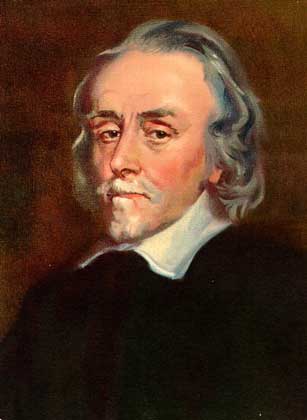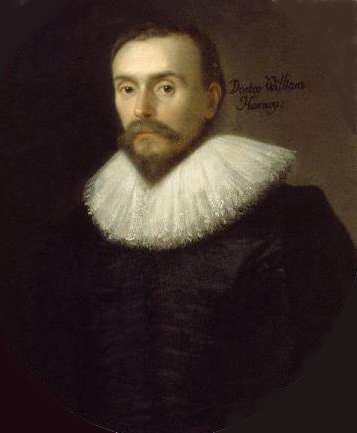<Back to Index>
- Physician William Harvey, 1578
- Novelist Nikolai Vasilievich Gogol, 1809
- Holy Roman Emperor Louis IV, 1282
PAGE SPONSOR


William Harvey (1 April 1578 – 3 June 1657) was an English physician who was the first to describe correctly and in exact detail the systemic circulation and properties of blood being pumped around the body by the heart.
Harvey's father Thomas Harvey, was a jurat of Folkestone where he served the office of mayor in 1600. Records and personal descriptions delineate him as an overall calm, diligent and intelligent man whose "sons... revered, consulted and implicitly trusted in him... (they) made their father the treasurer of their wealth when they acquired great estates... (He) kept, employed and improved their gainings to their great advantage." Thomas Harvey's portrait can still be seen in the central panel of a wall of the dining room at Rolls Park, Chigwell, in Essex.
Harvey's initial education was carried out in Folkestone, where he learned Latin. He then entered the King's School (Canterbury). Harvey remained at the King's School for five years, after which he joined Caius College in Cambridge. Harvey graduated as a Bachelor of Arts from Caius College in 1597. He then traveled through France and Germany to Italy, where he entered the University of Padua, apparently in 1598. During Harvey's years of study there, he developed a relationship with Fabricius and read Fabricius' De Venarum Ostiolis. Harvey graduated as a Doctor of Medicine at the age of 24 from the University of Padua on April 25, 1602. It reports that Harvey had
"conducted himself so wonderfully well in the examination and had shown such skill, memory and learning that he had far surpassed even the great hopes which his examiners had formed of him."
After graduating from Padua, Harvey immediately returned to England where he obtained the degree of Doctor of Medicine from the University of Cambridge that same year. Following this, Harvey established himself in London, joining the College of Physicians on October 5, 1604. A few weeks after his admission, Harvey married Elizabeth Browne, "daughter of Lancelot Browne, (himself) Dr. Physic". They had no children. Elected a Fellow of the College of Physicians on June 5, 1607, Harvey accepted a position at St. Bartholomew's Hospital that
he was to occupy for almost all the rest of his life. Succeeding a Dr
Wilkinson on October 14, 1609, he became the Physician in charge at St. Bartholomew's Hospital, which enjoined him, "in God's
most holy name" to "endeavor yourself to do the best of your knowledge
in the profession of physic to the poor then present, or any other of
the poor at any time of the week which shall be sent home unto you by
the Hospitaller... You shall not, for favor, lucre or gain, appoint or
write anything for the poor but such good and wholesome things as you
shall think with your best advice will do the poor good, without any
affection or respect to be had to the apothecary. And you shall take no
gift or reward... for your counsel... This you will promise to do as
you shall answer before God... " Harvey earned around thirty-three pounds a year and lived in a small house in Ludgate, although two houses in West Smithfield The next important phase of Harvey's life began with his appointment to the office of Lumleian lecturer on 4 August 1615. The Lumleian lectureship, founded by a Lord Lumley and
a Dr. Caldwell in 1583, consisted in pronouncing lectures for a period
of seven years, with the purpose of "spreading light" and increasing
the general knowledge of anatomy throughout England. Harvey
began his lectures in April 1616. At this time, at the age of
thirty-seven, he was described as "a man of lowest stature, round
faced; his eyes small, round, very black and full of spirit; his hair
as black as a raven and curling". The notes which he used at the time are preserved in the British Museum. Harvey continued to participate in the Lumleain lectures while also taking care of his patients at St. Bartholomew's Hospital;
he thus soon attained an important and fairly lucrative practice, which
climaxed with his appointment as 'Physician Extraordinary' to King James I on 3 February 1618. He seems to have similarly served various aristocrats, including Lord Chancellor Bacon. In 1628 he published in Frankfort-on-the-Main his completed treatise on the circulation of the blood, the De Motu Cordis. As a result of negative comments by other physicians Harvey "fell mightily in his practice", but
continued advancing his career. He was re-elected 'Censor' of the
College of Physicians in 1629, having been elected for the first time
in 1613 and the second time in 1625. Eventually, Harvey was also
elected Treasurer of the College. At the age of fifty-two, Harvey received commands by King James I to accompany the Duke of Lennox during his trip abroad. This voyage - the first after his return from Padua - lasted three years, taking Harvey through the countries of France and Spain during the Mantuan War and Plague. During this journey he wrote to Viscount Dorchester: "I
can complain that by the way we could scarce see a dog, crow, kite,
raven or any other bird, or anything to anatomize, only some few
miserable people, the relics of the war and the plague where famine had
made anatomies before I came. It is scarce credible in so rich,
populous, and plentiful countries as these were that so much misery and
desolation, poverty and famine should in so short a time be, as we have
seen. I interpret it well that it will be a great motive for all here
to have and procure assurance of settled peace. It is time to leave fighting when there is nothing to eat, nothing to be keep, and nothing to be gotten". Having returned to England in 1632, Harvey was named 'Physician in Ordinary' to the newly appointed King Charles I and
accompanied him wherever he went. In particular, Charles' hunting
expeditions gave Harvey access to many deer carcasses; it was upon them
that Harvey made many observations and consequent theories. During the English Civil War a
mob of citizen-soldiers against the King entered Harvey's lodgings,
stole his goods, and scattered his papers. The papers consisted of the
records of a large number of dissections... of diseased bodies, with
this observations on the development on insects, and a series of notes
on comparative anatomy." During this period, Harvey maintained his position, helped the wounded on several occasions and protected the King's children. The conflicts of the Civil War soon led King Charles to Oxford, with Harvey attending, where the physician was made 'Doctor of Physic' in 1642 and later Warden of Merton College in 1645. "In Oxford he
(Harvey) very soon settled down to his accustomed pursuits, unmindful
of the clatter of arms and of the constant marching and countermarching
around him, for the city remained the base of operations until its
surrender... " The
surrender of Oxford in 1645 marks the beginning of Harvey's gradual
retirement from public life and duties. Now sixty-eight years old and
childless, Harvey had lost three brothers and wife at this time. He
thus decided to return to London and live with his brothers Eliab and
Daniel separately and in different periods of time. Having retired from St Bartholomew's Hospital and
his various other aforementioned positions, he passed most of this time
reading general literature. Several attempts to bring Harvey back into
the 'working world' were made, however; here is an excerpt of one of
Harvey's answers: "Would
you be the man who should recommend me to quit the peaceful haven where
I now pass my life and launch again upon the faithless sea? You know
full well what a storm my former lucubrations raised. Much better is it
oftentimes to grow wise at home and in private, than by publishing what
you have amassed with infinite labour, to stir up tempests that may rob you of peace and quiet for the rest of your days." Harvey died at Roehampton in the house of this brother Eliab on 3 June 1657. Descriptions of the event seem to show that he died of a cerebral hemorrhage from vessels long injured by gout: it is highly probable that the left Sylvian artery malfunctioned, leading to a gradual accumulation of blood to the brain which
eventually overwhelmed it. His will distributed his material goods and wealth throughout his extended family also left a substantial amount of money to the College of Physicians. Harvey was buried in Hempstead, Essex.
The funeral procession started on the 26 June 1657 leading Harvey to be
placed in the 'Harvey Chapel' built by Eliab. The conditions of
Harvey's burial are also known: "Harvey was laid in the chapel between
the bodies of his two nieces, and like them he was lept in lead, coffin less ". On St. Luke's Day, October 18, 1883, Harvey's remains were reinterred, the leaden case carried from the vault by eight Fellows of the College of Physicians, and deposited in a sarcophagus containing his works and an inscription.
were attached as fringe benefits to the post of Physician. At this point,
the physician's function consisted of a simple but thorough analysis of
patients who were brought to the hospital once a week and the
consequent writing of prescriptions.